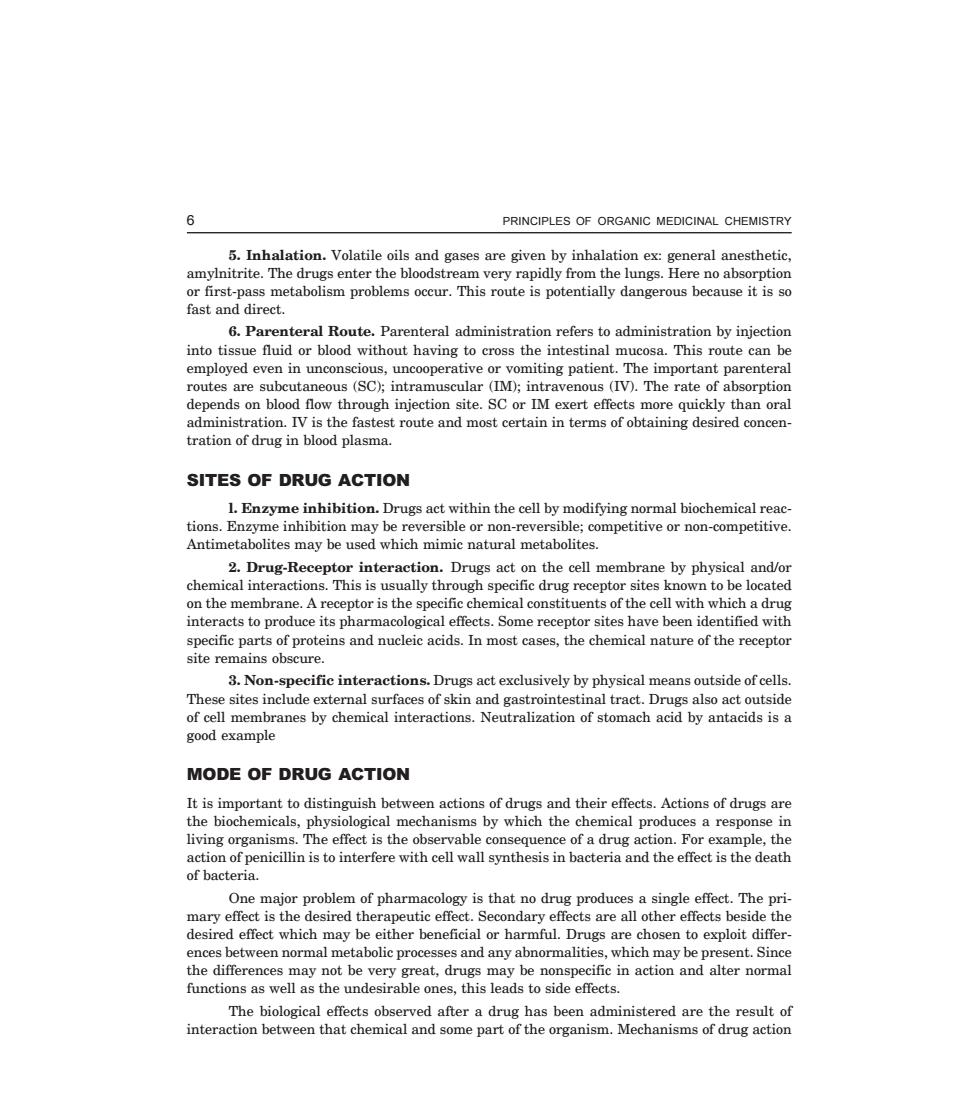正在加载图片...

6 PRINCIPLES OF ORGANIC MEDICINAL CHEMISTRY 5.Inhalation.Volatile oils and gases are given by inhalation ex:general anesthetic, amylnitrite.The drugs enter the bloodstream very rapidly from the lungs.Here no absorption or first-pass metabolism problems occur.This route is potentially dangerous because it is so fast and direct. 6.Parenteral route.Parenteral administration refers to administration by iniection into tissue fluid or blood without having to cross the intestinal m osa.This route employed even in unconscious,uncooperative or vomiting patient.The imp routes are subcutaneous (SC);intramuscular(IM):intravenous (IV).The rate of absorption depends on blood flow through injection site.SC or IM exert effects more quickly than oral administration.IV is the fastest route and most certain in terms of obtaining desired concen- tration of drug in blood plasma. SITES OF DRUG ACTION 1.Enzyme inhibition.Drugs act within the cell by modifving normal biochemical reac. tions.Enzyme inhibition may be reversible or non-reversible;competitive or non-competitive. Antimetabolites may be used which mimic natural metabolites. 2.Drug-Re epterinteractinD ugs act on the cell membrane by phy 。1 11 no A rece of the cell ith which a d interacts to produce its been identifed with rts of proteins and nucleic acids.In most cases.the chemical nature of the receptor re. 3.Nor ecific interactions.Drugs act exclusively by ph hysical means outside of cells s of sk d ga trac MODE OF DRUG ACTION ntiohemicalaphys ogical hanis s by which the cn duc es a response ng orga arewithcel con he nd the of One major problem of pharmacology is that no drug produces a single effect.The pri- mary effect is the desired therapeutic effect.Secondary effects are all other effects beside the desired effect which may be either beneficial or harmful.Drugs are chosen to exploit differ abonc proc s and any aonormal may b rence in action and The biological effects observed after a drug has been administered are the result of interaction between that chemical and some part of the organism.Mechanisms of drug action 6 PRINCIPLES OF ORGANIC MEDICINAL CHEMISTRY C-8—N-CHEMI\CHE2-1.PM5 5. Inhalation. Volatile oils and gases are given by inhalation ex: general anesthetic, amylnitrite. The drugs enter the bloodstream very rapidly from the lungs. Here no absorption or first-pass metabolism problems occur. This route is potentially dangerous because it is so fast and direct. 6. Parenteral Route. Parenteral administration refers to administration by injection into tissue fluid or blood without having to cross the intestinal mucosa. This route can be employed even in unconscious, uncooperative or vomiting patient. The important parenteral routes are subcutaneous (SC); intramuscular (IM); intravenous (IV). The rate of absorption depends on blood flow through injection site. SC or IM exert effects more quickly than oral administration. IV is the fastest route and most certain in terms of obtaining desired concentration of drug in blood plasma.
l. Enzyme inhibition. Drugs act within the cell by modifying normal biochemical reactions. Enzyme inhibition may be reversible or non-reversible; competitive or non-competitive. Antimetabolites may be used which mimic natural metabolites. 2. Drug-Receptor interaction. Drugs act on the cell membrane by physical and/or chemical interactions. This is usually through specific drug receptor sites known to be located on the membrane. A receptor is the specific chemical constituents of the cell with which a drug interacts to produce its pharmacological effects. Some receptor sites have been identified with specific parts of proteins and nucleic acids. In most cases, the chemical nature of the receptor site remains obscure. 3. Non-specific interactions. Drugs act exclusively by physical means outside of cells. These sites include external surfaces of skin and gastrointestinal tract. Drugs also act outside of cell membranes by chemical interactions. Neutralization of stomach acid by antacids is a good example
It is important to distinguish between actions of drugs and their effects. Actions of drugs are the biochemicals, physiological mechanisms by which the chemical produces a response in living organisms. The effect is the observable consequence of a drug action. For example, the action of penicillin is to interfere with cell wall synthesis in bacteria and the effect is the death of bacteria. One major problem of pharmacology is that no drug produces a single effect. The primary effect is the desired therapeutic effect. Secondary effects are all other effects beside the desired effect which may be either beneficial or harmful. Drugs are chosen to exploit differences between normal metabolic processes and any abnormalities, which may be present. Since the differences may not be very great, drugs may be nonspecific in action and alter normal functions as well as the undesirable ones, this leads to side effects. The biological effects observed after a drug has been administered are the result of interaction between that chemical and some part of the organism. Mechanisms of drug action����